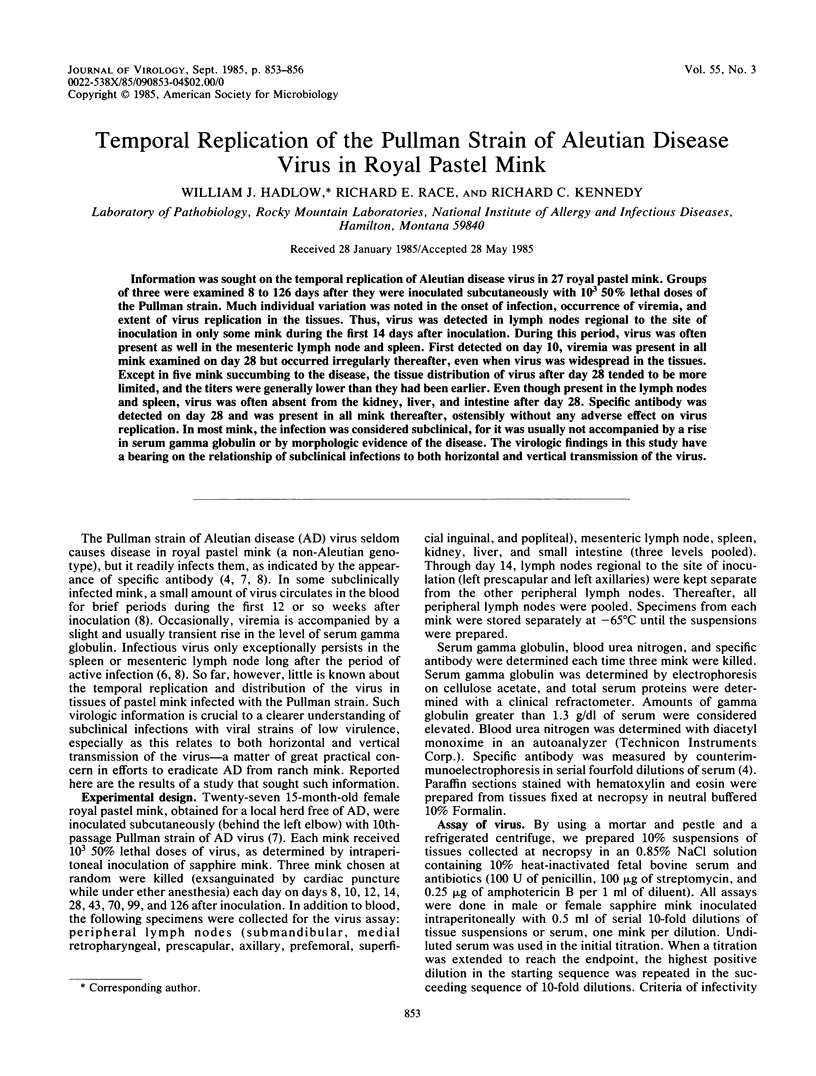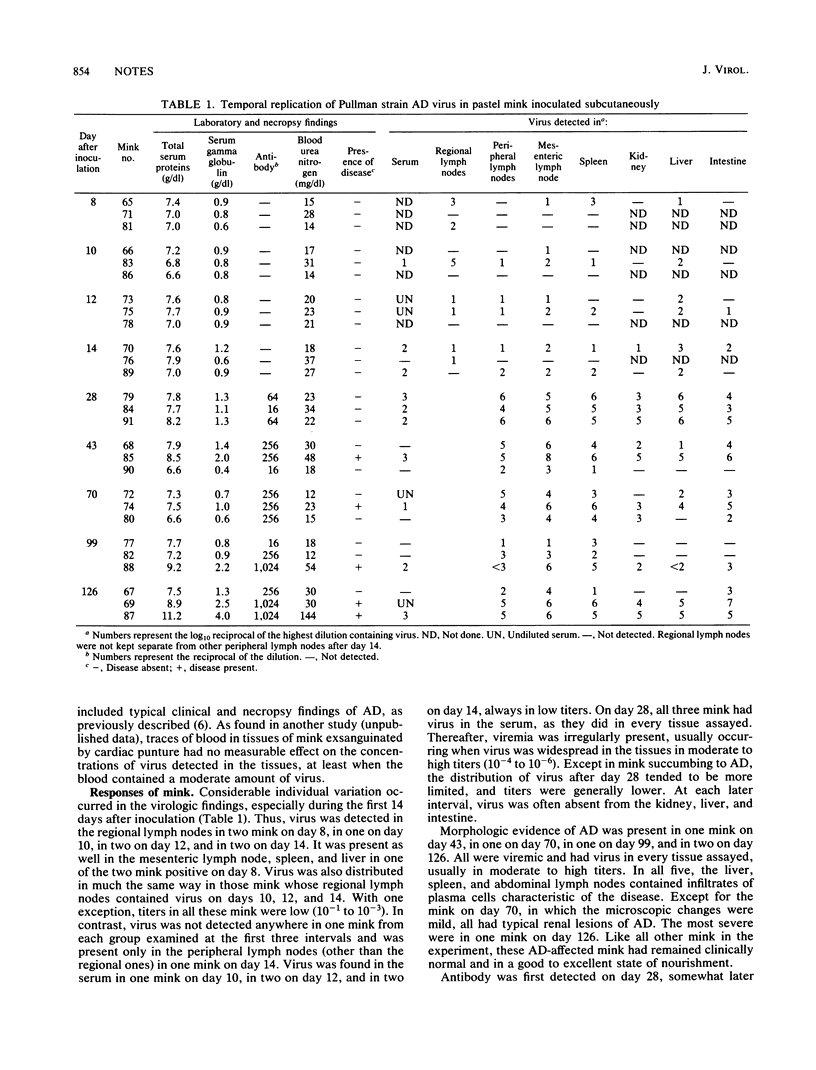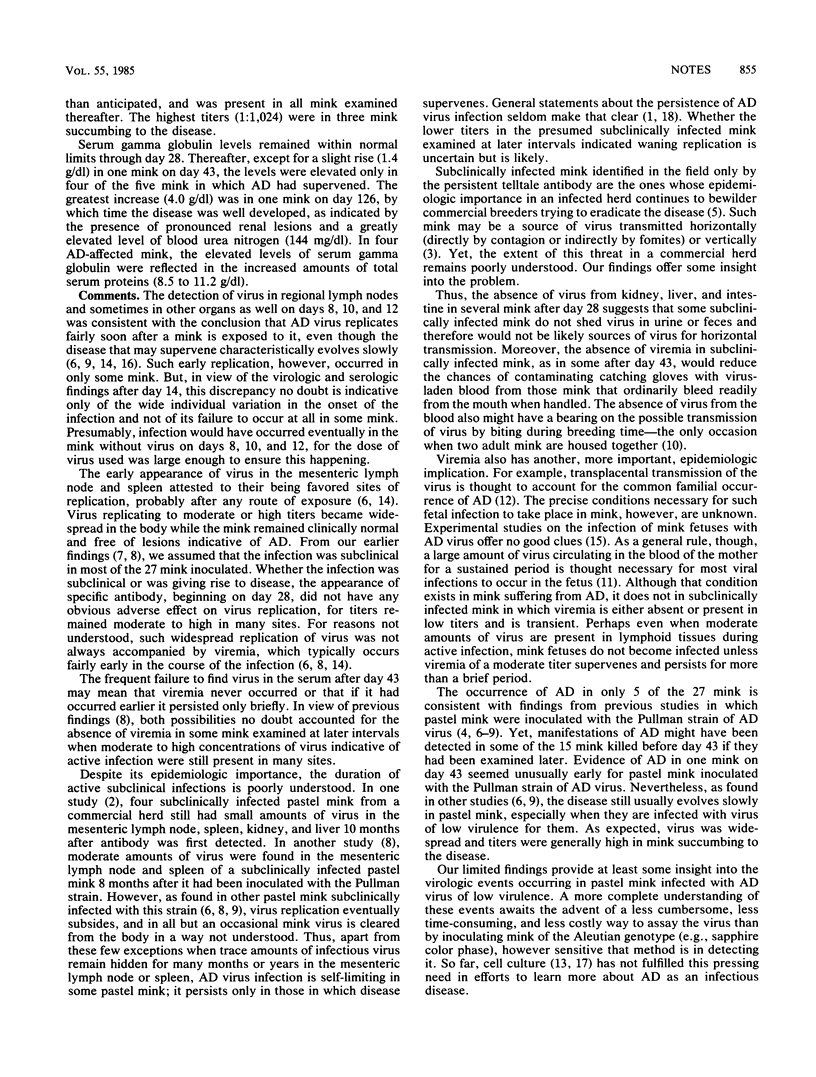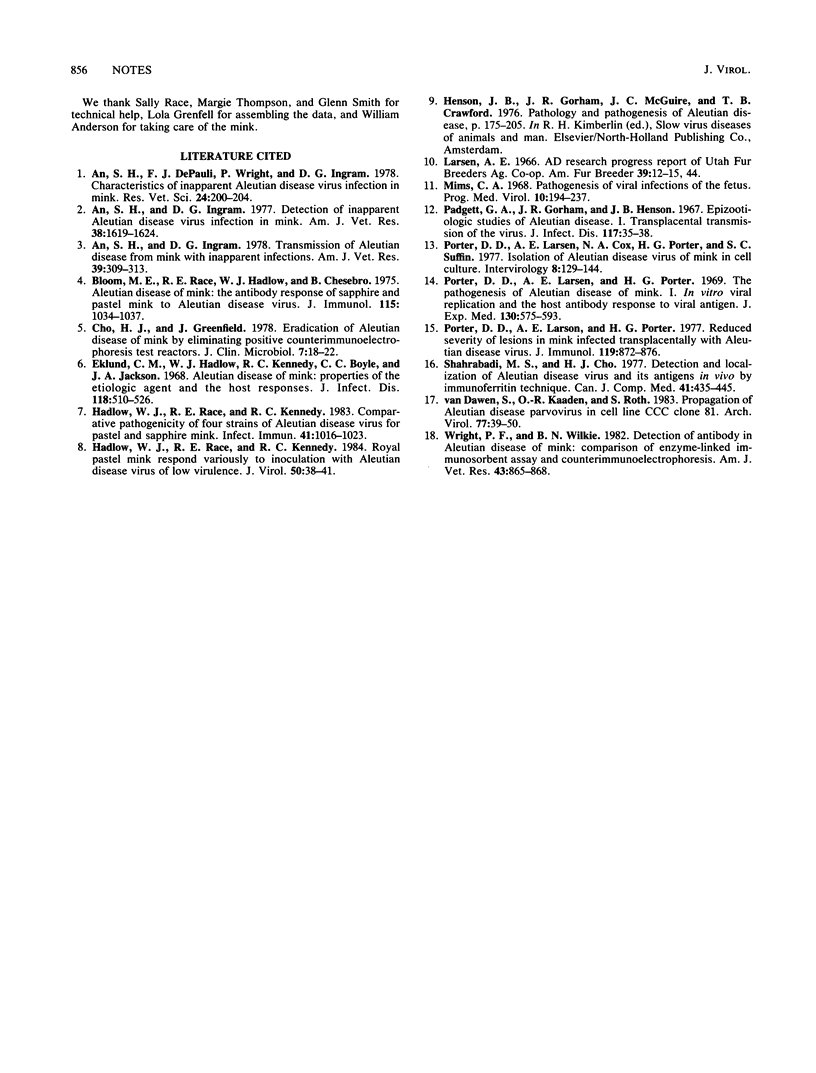Abstract
Information was sought on the temporal replication of Aleutian disease virus in 27 royal pastel mink. Groups of three were examined 8 to 126 days after they were inoculated subcutaneously with 10(3) 50% lethal doses of the Pullman strain. Much individual variation was noted in the onset of infection, occurrence of viremia, and extent of virus replication in the tissues. Thus, virus was detected in lymph nodes regional to the site of inoculation in only some mink during the first 14 days after inoculation. During this period, virus was often present as well in the mesenteric lymph node and spleen. First detected on day 10, viremia was present in all mink examined on day 28 but occurred irregularly thereafter, even when virus was widespread in the tissues. Except in five mink succumbing to the disease, the tissue distribution of virus after day 28 tended to be more limited, and the titers were generally lower than they had been earlier. Even though present in the lymph nodes and spleen, virus was often absent from the kidney, liver, and intestine after day 28. Specific antibody was detected on day 28 and was present in all mink thereafter, ostensibly without any adverse effect on virus replication. In most mink, the infection was considered subclinical, for it was usually not accompanied by a rise in serum gamma globulin or by morphologic evidence of the disease. The virologic findings in this study have a bearing on the relationship of subclinical infections to both horizontal and vertical transmission of the virus.
Full text
PDF



Selected References
These references are in PubMed. This may not be the complete list of references from this article.
- An S. H., DePauli F. J., Wright P., Ingram D. G. Characteristics of inapparent Aleutian disease virus infection in mink. Res Vet Sci. 1978 Mar;24(2):200–204. [PubMed] [Google Scholar]
- An S. H., Ingram D. G. Detection of inapparent Aleutian disease virus infection in mink. Am J Vet Res. 1977 Oct;38(10):1619–1624. [PubMed] [Google Scholar]
- An S. H., Ingram D. G. Transmission of Aleutian disease from mink with inapparent infections. Am J Vet Res. 1978 Feb;39(2):309–313. [PubMed] [Google Scholar]
- Bloom M. E., Race R. E., Hadlow W. J., Chesebro B. Aleutian disease of mink: the antibody response of sapphire and pastel mink to Aleutian disease virus. J Immunol. 1975 Oct;115(4):1034–1037. [PubMed] [Google Scholar]
- Cho H. J., Greenfield J. Eradication of Aleutian disease of mink by eliminating positive counterimmunoelectrophoresis test reactors. J Clin Microbiol. 1978 Jan;7(1):18–22. doi: 10.1128/jcm.7.1.18-22.1978. [DOI] [PMC free article] [PubMed] [Google Scholar]
- Eklund C. M., Hadlow W. J., Kennedy R. C., Boyle C. C., Jackson T. A. Aleutian disease of mink: properties of the etiologic agent and the host responses. J Infect Dis. 1968 Dec;118(5):510–526. doi: 10.1093/infdis/118.5.510. [DOI] [PubMed] [Google Scholar]
- Hadlow W. J., Race R. E., Kennedy R. C. Comparative pathogenicity of four strains of Aleutian disease virus for pastel and sapphire mink. Infect Immun. 1983 Sep;41(3):1016–1023. doi: 10.1128/iai.41.3.1016-1023.1983. [DOI] [PMC free article] [PubMed] [Google Scholar]
- Hadlow W. J., Race R. E., Kennedy R. C. Royal pastel mink respond variously to inoculation with Aleutian disease virus of low virulence. J Virol. 1984 Apr;50(1):38–41. doi: 10.1128/jvi.50.1.38-41.1984. [DOI] [PMC free article] [PubMed] [Google Scholar]
- Henson J. B., Gorham J. R., McGuire T. C., Crawford T. B. Pathology and pathogenesis of Aleutian disease. Front Biol. 1976;44:175–205. [PubMed] [Google Scholar]
- Mims C. A. Pathogenesis of viral infections of the fetus. Prog Med Virol. 1968;10:194–237. [PubMed] [Google Scholar]
- Padgett G. A., Gorham J. R., Henson J. B. Epizootiologic studies of Aleutian disease. I. Transplacental transmission of the virus. J Infect Dis. 1967 Feb;117(1):35–38. doi: 10.1093/infdis/117.1.35. [DOI] [PubMed] [Google Scholar]
- Porter D. D., Larsen A. E., Cox N. A., Porter H. G., Suffin S. C. Isolation of Aleutian disease virus of mink in cell culture. Intervirology. 1977;8(3):129–144. doi: 10.1159/000148888. [DOI] [PubMed] [Google Scholar]
- Porter D. D., Larsen A. E., Porter H. G. Reduced severity of lesions in mink infected transplacentally with Aleutian disease virus. J Immunol. 1977 Sep;119(3):872–876. [PubMed] [Google Scholar]
- Porter D. D., Larsen A. E., Porter H. G. The pathogenesis of Aleutian disease of mink. I. In vivo viral replication and the host antibody response to viral antigen. J Exp Med. 1969 Sep 1;130(3):575–593. doi: 10.1084/jem.130.3.575. [DOI] [PMC free article] [PubMed] [Google Scholar]
- Shahrabadi M. S., Cho H. J. Detection and localization of aleutian disease virus and its antigens in vivo by immunoferritin technique. Can J Comp Med. 1977 Oct;41(4):435–445. [PMC free article] [PubMed] [Google Scholar]
- Wright P. F., Wilkie B. N. Detection of antibody in Aleutian disease of mink: comparison of enzyme-linked immunosorbent assay and counterimmunoelectrophoresis. Am J Vet Res. 1982 May;43(5):865–868. [PubMed] [Google Scholar]
- van Dawen S., Kaaden O. R., Roth S. Propagation of Aleutian disease parvovirus in cell line CCC clone 81. Arch Virol. 1983;77(1):39–50. doi: 10.1007/BF01314862. [DOI] [PubMed] [Google Scholar]


